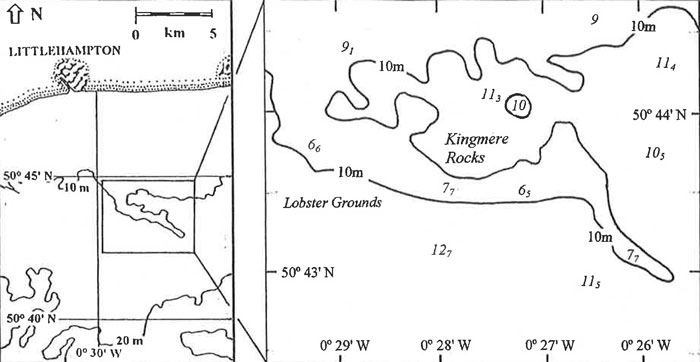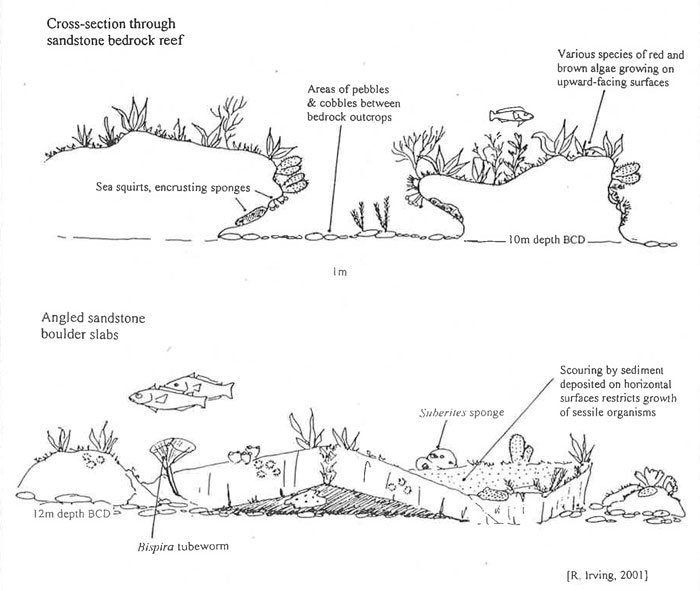SUSSEX MARINE SITES OF NATURE CONSERVATION IMPORTANCE
| Site: Kingmere Rocks | Ref. No. 16 | ||||||
| Location: 10 km SSE of Littlehampton | Other conservation designation?: No |
||||||
| Lat./Long. position of centre of site: 50° 43' 53" N 0° 27' 62" W |
OS grid ref. of centre of site: TV 086 929 |
Author: Robert Irving |
|||||
| Sea bed type: Sandstone & mudstone reefs, mostly of boulders, cobbles and mixed ground. |
Depth range (below chart datum): 6-14 m |
Date identified: June 2001 |
|||||
Summary
Kingmere Rocks encompasses a large area (in the region of 0.5 sq. nautical miles) of uneven seabed, consisting of outcrops of sandstone rising 2-3 m above the surrounding seabed, with boulders and mixed sediment areas in between. The boulders are frequently in the form of large rectangular slabs, 1-2 m in width/length and 20-50 cm thick (see also the Waldrons reef, mSNCI ref. 5). Although the depth of the seabed ranges from 6-14 m BCD, there is very little obvious slope to the seabed. In places, horizontal exposures of mudstone are present amongst the mixed sediment areas.
Biological Description
The upward-facing surfaces of sandstone bedrock and boulders are covered by marine life, the tops of the shallower ones (< 8 m depth BCD) having a covering of foliose red algae, whilst those slightly deeper are dominated by a dense animal turf, particularly the bryozoans Bugula spp. and Flustra foliacea. Extensive patches of encrusting coralline algae are present on the sides of the boulders, together with various sponges (Esperiopsis fucorum, Dysidea fragilis, Tethya aurantium, Suberites ficus and Polymastia mamilaris), dead man's fingers Alcyonium digitatum, sea squirts (especially Clavelina lepadiformis, Aplidium punctum and Morchellium argus), and occasional starfish Asterias rubens. The mud tubes of fan worms (particularly Bispira volutacornis) protrude from the cracks between boulders, and edible crabs Cancer pagurus are frequently encountered sheltering under overhangs. A narrow band at the base of bedrock outcrops and boulders is scoured clean of encrusting marine life by periodic movement of surrounding sediment. Fish associated with the reef areas include bib Trisopterus luscus, tompot blenny Parablennius gattorugine and ballan wrasse Labrus bergylta, though the most frequently recorded wrasse species from here has been the goldsinny Ctenolabrus rupestris.
Areas between the reef have a seabed of mixed sediments, consisting of cobbles, pebbles, gravel, shells and sand. Occasionally, there are chalk cobbles and pebbles in amongst the flints. Most of the fauna here is mobile, reflecting the unstable nature of the sediments, such as hermit crabs, netted dogwhelks Hinia reticulata and gobies. However, there may also be the occasional dahlia anemone Urticina felina and the odd cobble or pebble with encrustations of keelworms Pomatoceros triqueter.
Justification
Sublittoral rocky reefs account for probably less than 3% of the total area of seabed off Sussex (within the 12 nm limit of territorial waters). Kingmere Rocks is an example of a sandstone reef area with a rich and diverse fauna and flora associated with it.
References:Irving, R. A. 1998. Sussex Marine Life - an identification guide for divers East Sussex Council, Lewes |
|||||||
| Sussex SEASEARCH dive nos.: 711/36, 712/102, 713/17, 21, 22, 25, 146 & 147 | |||||||
| Sussex Sublittoral Survey site no.: 83/43 | |||||||
Site Location

Diagrammatic representation of site: Kingmere Rocks


:Link to this page
Copyright Sussex Biodiversity Records Centre © 2025